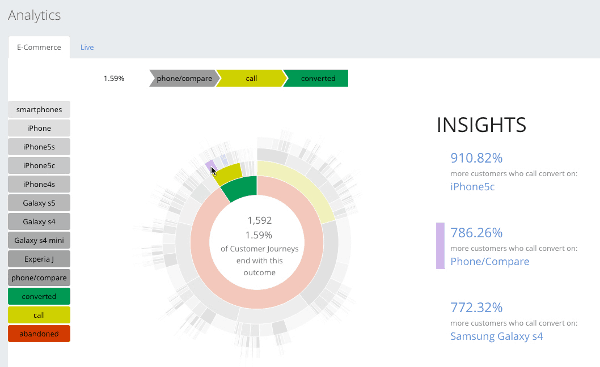WebRTC in contact centers. Somewhat.
To me, WebRTC in contact centers was always one of 3 options:
- Have website visitors “dial in” using WebRTC
- Have agents receive calls in their browser using WebRTC
- Have sales people call “others” from within the CRM system
 Seems like I missed a very interesting alternative – one that makes a lot of sense. I’ve known for some time that Altocloud uses WebRTC but until recently didn’t really dig into what that meant. And when I learned, I knew I had to have Barry O’Sullivan here in my interview series.
Seems like I missed a very interesting alternative – one that makes a lot of sense. I’ve known for some time that Altocloud uses WebRTC but until recently didn’t really dig into what that meant. And when I learned, I knew I had to have Barry O’Sullivan here in my interview series.
Barry O’Sullivan is the CEO of Altocloud. He was willing to answer my questions on how they “flip the coin” and predict which web or app visitors will benefit the most from live communications, and along the way he talks about how contact centers must adapt to the digital world.
What is Altocloud all about?
Altocloud is the digital communications alternative for today’s digital businesses. Traditionally companies have built phone call centers to handle live interaction. These have been completely separate from their online presence leading to high expense and bad customer experiences. It’s an analog experience in a digital world.
Altocloud helps companies increase sales whether it’s more conversions for an e-commerce website or higher value leads for inside sales. We do this by profiling an organization’s online prospects and customers and using machine learning to predict the best way to communicate live with the right prospects and customers – while they are on the site or using an app.
Our focus is on “why” and “when” live communications should occur, with machine learning and predictive analytics technologies being our primary focus. Communications technology, including WebRTC as we will discuss, then comes along as an easy way of supporting certain “in context” real-time interactions.
We find that “born digital” companies already get this and are very receptive to quickly deploying analytics-driven capabilities on their sites and rapidly exploring to see what is effective for them. I believe that more traditional companies are struggling to compete and need to increase their digital flexibility – and I commented on this on NoJitter recently (see here).

What is it that you do with WebRTC?
We embed WebRTC seamlessly into our product to support voice and video between visitors and sales representatives. Our customers don’t have to do anything – real-time communications is just there and will be used as needed from our small JavaScript analytics snippet that is easily added to their site pages.
However, we see ourselves as “communications neutral“ and also provide HTML-based chat and content personalization, PSTN integration for phone callbacks and call-ins, and integration with other communications technology including Cisco Jabber Guest and Cisco collaboration products. So we use WebRTC because it is seamless and powerful, but as just one possible way to communicate from a range of choices.
I know technical WebRTC folks always ask, so let me say that we are not currently using the WebRTC data channel. Our central SaaS platform is managing all the analytics and interactions with RESTful APIs and WebSockets as appropriate.

You took the approach of reversing the usual use case of WebRTC click-2-talk, having the contact center reach out to the web user. Why is that?
Because this is the key business problem – how to interact with the right people to drive business results!
Companies are still putting 800-phone-numbers on web pages and letting prospects and customers, most of whom won’t call, have horrible disjointed experiences. This cannot be the right way forward for digital business!
In a digital world, real-time communications has to be embedded right within websites and applications, providing reps with the entire online context when they interact with a customer – hence the role for WebRTC. However, just adding a click-to-call button on every screen is not really changing the business model.
The next big question was “there are millions of visitors on your site, who should you talk to?” The ‘aha’ for us was realizing that instead of just waiting and hoping that people would press a button, machine learning and predictive analytics approaches can be used to predict which customer journeys will most benefit from live interactions, and using this information to proactively make offers to the right visitors to personalize their journeys. This then became the core of our “Predictive Communications” product.
I understand that WebRTC takes a secondary role in your service. Where’s the majority of your focus then and why?
When a live voice and video WebRTC interaction is occurring between a visitor and a sales rep then obviously that technology is center stage at that moment – as a seamless integrated experience. But the business issue we are solving is why this interaction should be occurring in the first place and what is the entire online context that is needed to make that decision and provide Reps with everything they need to continue the conversation?
Therefore our primary focus is tracking all online customer journeys, whether or not an interaction occurs, understanding visitor “personas” and journey patterns, and making decisions such as “visitors like Tsahi, when they exhibit this kind of digital behavior, are more likely to convert when they have a video conversation with Reps like Barry” and then making these “in the moment” interactions happen.
Our application is focused on driving increased sales, better e-commerce conversions and faster lead generation qualification and action. Real-time communications is a means to these ends, but it is just one ingredient. Plus, you could say that the whole point of WebRTC is to make communications simple and secondary – something that is easy to add to a business application focused on other business value, like for us at Altocloud!
What signaling have you decided to integrate on top of WebRTC?
Signaling is handled within the Altocloud application, which is already concerned with tracking end-to-end customer journeys, managing logged-in representatives, automatically generating invites to visitors and connecting the right visitors with the right representatives. We are doing all this whether or not a WebRTC interaction occurs – so it is natural to just add WebRTC signaling and management into our application framework.
Backend. What technologies and architecture are you using there?
We have built a modern SaaS software stack horizontally scaled across globally distributed cloud instances. This stack includes Node.JS and MongoDB and we use Docker containerization to accelerate deployment and give us independence over underlying IaaS choices (see our CTO’s blog on this). We use Apache Spark, with a Kafka data pipeline, giving us a high performance analytics framework for our machine learning capabilities.
Given the opportunity, what would you change in WebRTC?
The fundamental challenge right now is that the industry needs to get Microsoft and Apple on-board and have WebRTC fully available across all major browsers. This is taking too long. We have experimented with plugins for IE and Safari but they are not a user experience approach that most customers we are working with want to introduce. This is especially true for B2C e-commerce companies where reducing website friction is paramount. Luckily, we have various alternatives in the Altocloud product including content personalization, chat, chat plus phone callback, other communications frameworks plus SDK approaches for mobile apps, but it is disappointing to not have easy WebRTC voice and video for visitors with certain browsers. Again, in the e-commerce world mobile browsers continue to grow as the primary access choice for consumers versus company-specific shopping apps – unless, perhaps, you happen to be Amazon. So full mobile browser support is very important for WebRTC success.
Where do you see WebRTC going in 2-5 years?
We think it will disappear! What I mean is WebRTC will become invisibly embedded in everything – from browsers to mobile devices to the Internet of Things – so that we can just rely on it for easy real-time communications wherever customers or prospects turn up.
If you had one piece of advice for those thinking of adopting WebRTC, what would it be?
Focus on the business problem! WebRTC is a means to an end – it makes it easy for application developers, like Altocloud, to include rich voice, video and data sharing into new applications. Don’t lock yourself into WebRTC as your only communications option. In the end, users will decide how they want to communicate irrespective of standards. Public messaging apps like Facebook Messenger and private messaging apps like Slack and Cisco Spark have a good shot at becoming the focus for communications – don’t let your stack choice isolate you from these communities.
What’s next for Altocloud?
Our goal for 2015 is to grow our customer base and to continue to show the business value of Predictive Communications to the marketplace. Increasing our presence in the e-commerce and sales lead-generation communities will be key for this. Customers can come and sign-up today on our website Altocloud.com!
–
The interviews are intended to give different viewpoints than my own – you can read more WebRTC interviews.
